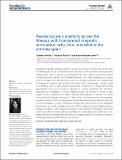| dc.contributor.author | Freitas, Catarina | |
| dc.contributor.author | Farzan, Faranak | |
| dc.contributor.author | Pascual-Leone, Alvaro | |
| dc.date.accessioned | 2013-11-05T22:15:01Z | |
| dc.date.issued | 2013 | |
| dc.identifier.citation | Freitas, Catarina, Faranak Farzan, and Alvaro Pascual-Leone. 2013. Assessing brain plasticity across the lifespan with transcranial magnetic stimulation: why, how, and what is the ultimate goal? Frontiers in Neuroscience 7:42. | en_US |
| dc.identifier.issn | 1662-4548 | en_US |
| dc.identifier.uri | http://nrs.harvard.edu/urn-3:HUL.InstRepos:11294951 | |
| dc.description.abstract | Sustaining brain and cognitive function across the lifespan must be one of the main biomedical goals of the twenty-first century. We need to aim to prevent neuropsychiatric diseases and, thus, to identify and remediate brain and cognitive dysfunction before clinical symptoms manifest and disability develops. The brain undergoes a complex array of changes from developmental years into old age, putatively the underpinnings of changes in cognition and behavior throughout life. A functionally “normal” brain is a changing brain, a brain whose capacity and mechanisms of change are shifting appropriately from one time-point to another in a given individual's life. Therefore, assessing the mechanisms of brain plasticity across the lifespan is critical to gain insight into an individual's brain health. Indexing brain plasticity in humans is possible with transcranial magnetic stimulation (TMS), which, in combination with neuroimaging, provides a powerful tool for exploring local cortical and brain network plasticity. Here, we review investigations to date, summarize findings, and discuss some of the challenges that need to be solved to enhance the use of TMS measures of brain plasticity across all ages. Ultimately, TMS measures of plasticity can become the foundation for a brain health index (BHI) to enable objective correlates of an individual's brain health over time, assessment across diseases and disorders, and reliable evaluation of indicators of efficacy of future preventive and therapeutic interventions. | en_US |
| dc.language.iso | en_US | en_US |
| dc.publisher | Frontiers Media S.A. | en_US |
| dc.relation.isversionof | doi:10.3389/fnins.2013.00042 | en_US |
| dc.relation.hasversion | http://www.ncbi.nlm.nih.gov/pmc/articles/PMC3613699/pdf/ | en_US |
| dash.license | LAA | |
| dc.subject | Focused Review Article | en_US |
| dc.subject | brain plasticity | en_US |
| dc.subject | TMS | en_US |
| dc.subject | lifespan | en_US |
| dc.subject | aging | en_US |
| dc.subject | brain health index | en_US |
| dc.title | Assessing brain plasticity across the lifespan with transcranial magnetic stimulation: why, how, and what is the ultimate goal? | en_US |
| dc.type | Journal Article | en_US |
| dc.description.version | Version of Record | en_US |
| dc.relation.journal | Frontiers in Neuroscience | en_US |
| dash.depositing.author | Farzan, Faranak | |
| dc.date.available | 2013-11-05T22:15:01Z | |
| dc.identifier.doi | 10.3389/fnins.2013.00042 | * |
| dash.contributor.affiliated | Farzan, Faranak | |
| dash.contributor.affiliated | Pascual-Leone, Alvaro | |


